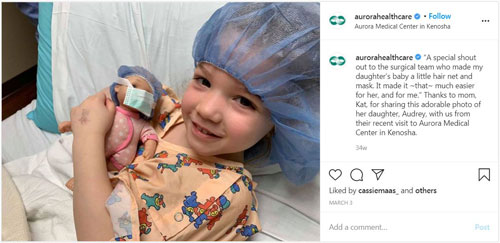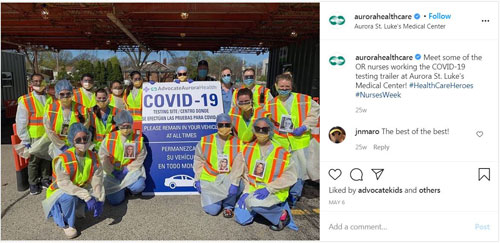SOCIAL MEDIA
How Advocate Aurora Health is Harnessing User-Generated Content to Keep Consumers Engaged During the Pandemic
Standing out in the social media universe can prove challenging when you’re competing with viral cat videos, short attention spans and the 24-hour news cycle. But marketers at Illinois- and Wisconsin-based Advocate Aurora Health have figured out how to cut through the noise and stay engaged by utilizing content generated by their own patients and providers.
The average person scrolls through 300 feet of content each day, according to Facebook’s Andrew Keller, which is equivalent to the height of the Statue of Liberty. That number is likely to climb higher thanks to a global pandemic shutting down many aspects of regular life and keeping people inside, noted Sarah Scroggins, director of social media for Advocate Aurora Health. “Attention spans are shorter now, more than ever,” she said.
But the 28-hospital system is addressing this trend, tallying a 185 percent increase in social media engagement since the start of the public health crisis. The surge is coming primarily through user-generated content that has seen three times more interaction than heavily produced marketing pieces created by Scroggins’ team.
“How do we break through that clutter?” she asked. “For us, it’s about being real, authentic and personal. We need to figure out a way to get people to stop on our content and potentially take action.”
Getting Started
For Advocate Aurora — the product of a 2018 merger — Instagram is where the content strategy “lives.” The majority of posts, Scroggins said, start on this image-based social platform, where marketers on her team can also share them to Facebook and Twitter.
They’ve targeted content that tells the nonprofit health system’s story, aligning with its priorities and patient care segments that represent opportunities for growth, such as the cardiovascular service line.
A good place to get started down this path, Scroggins advised, is to create guidelines for each channel. For example, Advocate Aurora does not share any stock photos, graphics or images that have been filtered on Instagram. It’s also crucial to identify any risks from sharing images created by patients or providers. The organization just recently established an easy online process to gain consent from patients and families, replacing the old school method of emailing a PDF file to gather someone’s signature. Eliminating printing and scanning, Scroggins said, has “dramatically improved our turnaround time.”
Marketers have also quickly learned the importance of fact-checking and reviewing images and the story behind them. Scroggins and her team, for instance, review users’ profiles, and ensure that all details of complex medical procedures are stated accurately. If necessary, they’ll reach out to the medical team for further clarification.
Scroggins stressed the importance of carefully combing over the background in images to make sure there are no visible medical bracelets or other identifying information.
“We’ve run into a lot of those instances with babies. It’s hard to crop a medical wrist band out of a foot or arm,” she said. “And so, we’re very careful.”
As far as actually finding pieces to promote, the Advocate Aurora team has set up daily check-ins for patient and provider images that may fit the bill. They hunt for Facebook posts, comments on their own content or hashtags. The team has created a detailed document that monitors the accounts of all 28 hospitals in the system, often executed by an intern to help them get acquainted with the organization.
Once they’ve pinpointed a post that fits their strategy, they write a comment and steer the conversation into direct messages to attempt to gain permission and then transition to email for further engagement.
Advocate Aurora aims to share about three to five new posts on each channel per week and use these new images to further build out its library.
“It is just an endless source of content, which is great,” Scroggins said.
Examples
 Social Media Manager Caitlin Ruiz noted numerous examples of recent posts from social media users. In one instance, a patient shared a picture posing with her longtime cardiologist, whom she surprised with a new tattoo of his initials and an inspiring quote from the doctor: “You told me I could, so I did.” Another post highlighted a pediatric patient whose nurses dressed his doll in a mask and hairnet to make him feel better about wearing such garments. A third showed a patient about to enter surgery who was first greeted by one of Advocate Aurora’s therapy dogs in the hallway.
Social Media Manager Caitlin Ruiz noted numerous examples of recent posts from social media users. In one instance, a patient shared a picture posing with her longtime cardiologist, whom she surprised with a new tattoo of his initials and an inspiring quote from the doctor: “You told me I could, so I did.” Another post highlighted a pediatric patient whose nurses dressed his doll in a mask and hairnet to make him feel better about wearing such garments. A third showed a patient about to enter surgery who was first greeted by one of Advocate Aurora’s therapy dogs in the hallway.
Seeing these stories on one’s social feed can prove powerful, Ruiz noted.
“We know that friends and family recommendations have a big impact on purchasing decisions and that’s been a theme in health care,” she said. “These endorsements on social can go a long way when you’re seeing them coming from a family member or trusted friend. And they are great opportunities for us to highlight our service lines, programs, team members and the overall patient experience.”
 As the COVID-19 pandemic took hold and patient visits slowed dramatically, Ruiz and Scroggins have pivoted to feature team members more frequently and use Instagram to emphasize that it’s safe to come back and receive care.
As the COVID-19 pandemic took hold and patient visits slowed dramatically, Ruiz and Scroggins have pivoted to feature team members more frequently and use Instagram to emphasize that it’s safe to come back and receive care.
“Where we are today is obviously very different from where we were three months ago. So, we’re looking at our social strategy and where we need to take it post COVID-19,” Scroggins said. “But I think showing what the patient experience looks like on social, to help people visualize it and understand that it’s safe to come back for care, will be more important than ever moving forward.”
To learn more, you can access a recording/slides of the program, “Showcasing the Patient Experience Through Social Media Content,” from the virtual conference Advanced Social Media and Digital Marketing in Health Care. It’s available now as part of a special post-conference, on-demand offering and registration is free. The event was hosted by the Mayo Clinic and SHSMD.
This article features interviews with:
Sarah Scroggins
Director, Social Media
Advocate Aurora Health
Downers Grove, Illinois
Caitlin Ruiz
Manager, Social Media
Advocate Aurora Health
Downers Grove, Illinois


